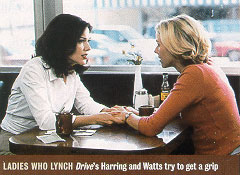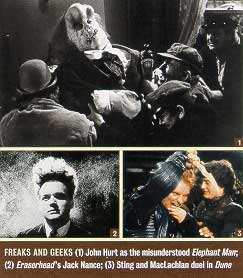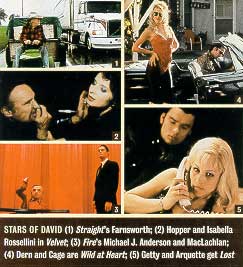
The mind behind MULHOLLAND DRIVE leads a tour through his twisted body of work.
by Jeff Jensen

The mind behind MULHOLLAND DRIVE leads a tour through his twisted body of work.
by Jeff Jensen
There's a dismembered bird's wing on David Lynch's desk. It's large and dirty and molted and just lying there, soaking up the sunshine that's pouring in through the windows of his hilltop painting studio in Los Angeles. The 55 year-old filmmaker, clad in khakis and a buttoned to-the-neck dress shirt and burning through cigarette after cigarette, says nothing of the grim object resting between him and his interviewer, as if its presence requires no explanation. But since dirty dismembered bird wings lying inexplicably on desks are, as a general rule, rather strange, you feel compelled to ask, and when you do, he smirks. "My assistant found this the other day and brought it to me," says the Montana native in his Western twang. "Sometimes I put stuff in my paintings, and he thought I could do something with it." Of course he could: After all, this is the oddball auteur who made a severed human ear the haunting central image of his 1986 masterpiece Blue Velvet. In fact, his ninth and latest feature, the trippy-sexy neo-noir Mulholland Drive, which opened to strong reviews and promising grosses on Oct. 12, is a cinematic salvage act, combining parts of a failed 1999 ABC pilot with footage shot last year. The result, which earned Lynch a shared best director honor at last spring's Cannes film festival, is Frankenstein created by a mad scientist under the influence of Vertigo and Sunset Boulevard (two of Lynch's favorite films).
 Drive is the twisted tale of a wide-eyed aspiring actress named Betty (Naomi Watts) whose life gets intertwined with a ravenhaired amnesiac (Laura Elena Harring) searching for her true identity. In between auditions, Betty plays Nancy Drew with her dusky new friend, and their investigation ultimately leads to a bloated corpse, a mysterious blue box, and a role-swapping denouement that defies rational analysis. Even his stars were befuddled when Lynch reconvened them last year, long after the shooting of the pilot. "I remember the day when David told Naomi and me,'Ladies, Mulholland DIrive is going to be an international feature film!"' recalls Harring,
perfectly nailing Lynch's accent. "We were so happy, but it wasn't until we left that we looked at each other and went, What exactly did we just agree to in there?" Adds Watts: "I would really try to siphon whatever I could out of him, but when he wouldn't give, I'd be like, 'Why are you doing this to me?' He was almost delighting in my torture!"
Drive is the twisted tale of a wide-eyed aspiring actress named Betty (Naomi Watts) whose life gets intertwined with a ravenhaired amnesiac (Laura Elena Harring) searching for her true identity. In between auditions, Betty plays Nancy Drew with her dusky new friend, and their investigation ultimately leads to a bloated corpse, a mysterious blue box, and a role-swapping denouement that defies rational analysis. Even his stars were befuddled when Lynch reconvened them last year, long after the shooting of the pilot. "I remember the day when David told Naomi and me,'Ladies, Mulholland DIrive is going to be an international feature film!"' recalls Harring,
perfectly nailing Lynch's accent. "We were so happy, but it wasn't until we left that we looked at each other and went, What exactly did we just agree to in there?" Adds Watts: "I would really try to siphon whatever I could out of him, but when he wouldn't give, I'd be like, 'Why are you doing this to me?' He was almost delighting in my torture!"
Maybe--or maybe he just didn't know what to say. Likening his creative process to that of the Surrealists, Lynch says all his movies "are made of ideas, strung together and forming a story and the world that comes with it. And I've always believed that if you remain true to the ideas, more often than not, that whole will hold together just correct."
Trusting in his gut has produced one of cinema's oddest oeuvres. Lynch became intrigued with filmmaking in the late 1960s while attending the Pennsylvania Academy of the Fine Arts in Philadelphia. After getting a grant from the American Film Institute for a 16mrn short called The Grandmother (1970), he enrolled at AFI in Los Angeles and soon began working on his first feature-length effort, Eraserhead.
THE FILMS:
ERASERHEAD (1977)
A shock-haired hero loses his
head (literally), kills his fish-eyed
child, and escapes into a radiator
where an angelic, lumpy-faced
lady lives. Maybe. All that was to
become "Lynchian"--dreamlike
narrative, freak-show characters,
ominous soundscapes, deadpan
detachment-was present in his
first feature. Lynch shot overfour
years, living and working in unused horse stables owned by the
AFI.
"It was like I died and
went to heaven. It looked like
stables from the outside, but inside it was another world. I know
ideas came from living in there
that wouldn't have come if we had
the money and could go faster. I
always think about doing a film
jike that again; there's something
about a small, intimate crew, living in a world for a long period of
time. There's just something
about it-the moving slowly."
 THE ELEPHANT MAN (1980)
THE ELEPHANT MAN (1980)
Lynch wanted to follow Eraserhead with the equally weird Ronnie Rocket, but couldn't find financing. Enter Mel Brooks,
whose production company was
searching for a director for a Victorian-era drama based on the
true story of the grossly deformed
John Merrick. The inspired pairing of sensibility and material
yielded a box office hit and eight
Oscar nods (including Best Picture and Best Director).
"The whole thing would never have
happened without Mel Brooks. I
didn't have final cut, but he in effect gave me final cut. When [studio execs] wanted to alter things,
he became the most powerful lion
and just devoured these enemies.
Pressure? On the first day, [actress] Wendy Hiller grabbed me
by the neck and walked me
around, saying, 'I don't know you.
I will be watching you.' It was that way throughout - heaven
and hell, thrown together."
DUNE (1984)
Many offers came Lynch's way
after The Elephant Man, including Return of the Jedi. Instead,
Lynch fatefully chose to adapt
Frank Herbert's sci-fi epic for
Uber producer Dino De Laurentiis Lambasted for its incoherence, miscasting (a then-un-
known Kyle MacLachlan made
his debut as a desert messiah),
and dingy veneer, Dune nearly
killed Lynch's career.
"You don't
really know until it's too late. But
you know the expression, 'Well
begun, half done'? It wasn't well
begun. From the beginning, it
was a slippery slope that kept go
ing downwards. I was two people: One that put one foot in front
of the other and does the work,
while the other one is right above
it, going insane. It wasn't pleasant. Still, I had no one to blame
but myself. I learned a lot from
that experience. Most importantly? Get final cut."
BLUE VELVET (1986)
What a comeback. Lynch made a
deal with De Laurentiis, giving
up half his fee in return for total
control of his next project. Starring MacLachlan as a college kid
whose voyeurism gets him into
big trouble with Dennis Hopper's
sadistic criminal, Blue Velvet
earned Lynch a second Best Director nomination. Legend has it
that he giggled while watching
Hopper performing in the film's
deeply disturbing rape sequence.
"If you believe in your work,
nothing can hurt you. But if you
don't believe in it, and it comes
out bad? Double whammy. That
was me after Dune. So with Blue
Velvet, there was nowhere to go
but up. I had euphoria in freedom
and it was beautiful. As for the
laughing story, it was like a dog
in a chocolate shop. It just starts
eating that chocolate and there's
no stopping it, it's just so obsessed. So to see Dennis just so
obsessed, so focused like that-it
just made me laugh."
WILD AT HEART (1990)
Starring Nicolas Cage as an
Elvis-idolizing rogue and Laura
Dern as a trashy Southern belle,
Lynch's hyper-pop romance won
the Palme d'Or at Cannes. But
the film was criticized in the U.S.
for its self-indulgence and extreme violence. It could have been
worse: To get an R rating, Lynch
had to cut a torture scene and obscure a shot in which Willem
Dafoe's head gets blown off.
"At that time, [Barry Gifford's] book
married with a feeling I had - a
feeling that the world was going
insane. But I did cross the line in
my first cuts; I was kind of pushing it to this place I felt was real,
but it was very sick and insane.
When 300 people out of 400 leave
the theater [during a test screen-
ing], for the sake of the whole,
you adjust! I've found the ratings
board wants to work with you.
They just say, 'We don't want to
tell you what to do, but if you can
help us, we would like that.'
Here, they were right."
 TWIN PEAKS: FIRE
WALK WITH ME (1992)
TWIN PEAKS: FIRE
WALK WITH ME (1992)
In October 1990, propelled by the
success of his TV series Twin
Peaks, Lynch found himself on
the cover of TIME magazine.
"Someone told me a TIME cover
curses you with two years' bad
luck," says Lynch. "That's what
happened." It kicked in the following spring, when Twin Peaks
was canceled, and continued into
Lynch's movie prequel, which
fans rejected for not resolving the
series' many riddles.
"I never
even thought about tying up the
loose ends. I wanted to go into
the last seven days of Laura
Palmer, and all the ideas came
out around that thinking. There
were other scenes shot that didn't
end up in the film, but they didn't
fit into this particular story. But
those were the days of the curse,
so I sort of knew it wouldn't go
over. Yet I loved the film, so it
didn't hurt me. So there it is."
LOST HIGHWAY (1997)
With a looping narrative similar
to Mulholland Drive's, Lynch's
noir/horror hybrid tells the twisted tale of a jealous husband (Bill
Pullman) who's convinced his
wife (Patricia Arquette) is cheating on him. After being convicted
of her murder and jailed, Pullman escapes - into the head of
Balthazar Getty. Then things really get weird. If you view it
again, keep this in mind: "Looking back now, I see that Lost
Highway was hugely influenced
by O.J. Simpson. Ask yourself:
How can O.J. golf? How can he
even hit the ball? How can he
even go out of bed in the morning? How does the mind seal itself off from horror and be able to
live and think and hit a golf ball?
So when you think about that,
and you think about Lost Highway ... it sort of makes sense!"
THE STRAIGHT STORY (1999)
Perhaps Lynch's most surprising
film: a sweet, decidedly linear fable based on the true story of an
old man (Oscar-nominated Richard Farnsworth) who traveled
across Iowa on a tractor to reconcile with his ailing brother. Free
of sex, violence, and ironic detachment, the sublime Story
shocked even the director's most
hardcore fans - by winning a G
rating. Some were moved to ask,
Just what is a David Lynch film?
"Who knows? [Laughs] It's ideas
that have passed through my machine. It's not just music. It's not
just pace. It's not just 'a look.' It's
a combo of things that have to be
correct. It reminds me of a symphony, when they have different
movements, and what goes before is critical to a big moment
coming up. So many things have
to be correct. Too little, it doesn't
happen; too much, it breaks it. So
it's a tricky business, making
movies. Just a tricky business."
© 2001 Entertainment Weekly Inc.
Back to the Lynch articles page